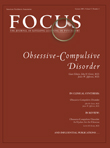From the Guest Editors
Clinical medicine lives between these polar dictates; sometimes boundaries are blurred when we consciously cause tolerable harm to achieve something helpful for a patient. Some side effects may be better borne than pathological conditions that disrupt functioning. Obsessive-compulsive disorder (OCD) makes this conundrum obvious. We advocate possible short-term increases in anxiety during behavior therapy to achieve large and long-term reductions in obsessions, compulsions, rituals, and anxiety. We explain tolerable side effects of medications that may lead to substantial benefit. For the most severe OCD, we may counsel neurosurgery with its attendant risks.
The aim of this issue of Focus is to present two close colleagues' views on treatment of OCD. Our perspective is buttressed by a more detailed review of published literature by Lorrin Koran, MD, Emeritus Professor of Psychiatry at Stanford, where he has directed the Obsessive Disorder Clinic since 1988.
Recognized through the ages, OCD is marked by homogeneous concerns of harm, risk, and danger from heterogeneous and ubiquitous sources of contamination, doubt, aggression, and loss. Obsessions are unwanted, intrusive, repetitive ideas, images, and impulses that patients usually recognize as inappropriate or excessive. Compulsions are urges, often strong, to do something to lessen distress from obsessions. Rituals are repetitive, purposeful behaviors, typically tied to obsessions and intended to diminish obsessions or the discomfort they cause. Thus, contamination obsessions lead to washing and cleaning rituals, doubt produces checking, aggressive obsessions evoke avoidance of the objects of aggression, and worry about loss produces hoarding.
Until relatively recently, OCD was thought to be a rare disorder as patients hid symptoms and signs and clinicians often misdiagnosed what they saw as something they might know how to treat more effectively. OCD is now recognized as a common and usually chronic disorder in adults that waxes and wanes in severity. Very few adult patients, but some children, have remissions spontaneously or after treatment. Ten or more years after receiving treatment at the Yale Child Study Center, patients' mean Yale-Brown Obsessive-Compulsive Scale (Y-BOCS) score was 10.2 and 64% continued taking serotonin reuptake inhibitors. Ten percent had Y-BOCS scores >24 and were considered to be severely ill (1). Put most positively, although based on varied outcome criteria, a meta-analysis concluded that >40% of children and adolescents may achieve good outcomes with subthreshold symptom severity (2). About 10% of patients with OCD experience a devastating downhill course until the disorder dominates their lives.
A fuller description of OCD and our approach to treatment follows and is followed, in turn, by Dr. Koran's review.
William Osler observed: “It is astonishing with how little reading a doctor can practice medicine, but it is not astonishing how badly he may do it.”
Recognizing the enduring truth of Osler's observation, we commend you for the reading you are about to do.
1 Dombrowski PA, Bloch M, Craiglow B, Panza K, Sukhodolsky D, Landeros-Weisenberger A, Peterson BS, Leckman JF: Adult outcome in children with obsessive-compulsive disorder. Neuropsychopharmacology 2006; 31( suppl 1): S225– S226Google Scholar
2 Stewart SE, Geller DA, Jenike M, Pauls D, Shaw D, Mullin B, Faraone SV: Long-term outcome of pediatric obsessive-compulsive disorder: a meta-analysis and qualitative review of the literature. Acta Psychiatr Scand. 2004; 110: 4– 13Crossref, Google Scholar



